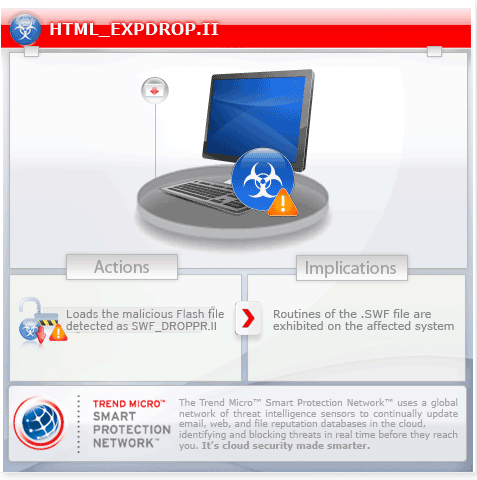HTML_EXPDROP.II
Exploit:Win32/Dufmoh.A (Microsoft), Bloodhound.Exploit.474 (Symantec), Exploit-IEexecCommand (McAfee), Trojan-Downloader.HTML.SWFLoad.g (Kaspersky)
Windows 2000, Windows XP, Windows Server 2003


Threat Type: Trojan
Destructiveness: No
Encrypted: No
In the wild: Yes
OVERVIEW
Downloaded from the Internet
This malicious HTML file exploits a zero-day vulnerability in Internet Explorer 7, 8, and 9. The exploit leads to the dropping of a PoisonIvy backdoor. PoisonIvy backdoors are known to be widely used in targeted malware attacks.
To get a one-glance comprehensive view of the behavior of this Trojan, refer to the Threat Diagram shown below.

It then loads a malicious Flash file, Moh2010.swf. As a result, malicious routines of the component file are exhibited on the affected system. The malicious Flash file is detected by Trend Micro as either SWF_DROPPR.II, SWF_DROPPR.IJ, SWF_DROPPER.IK, or SWF_DROPPR.IL.
This Trojan may be hosted on a website and run when a user accesses the said website.
TECHNICAL DETAILS
Varies
HTML, HTM
17 Sep 2012
Executes files
Arrival Details
This Trojan may be hosted on a website and run when a user accesses the said website.
NOTES:
This malware checks the user's browser version. It targets Internet Explorer versions 7 and 8 on Windows XP. Some variants of this malware also targets Internet Explorer versions 8 and 9 on a 32-bit Windows 7 whose Java version is neither 6 nor 7.
It loads the malicious Flash file Moh2010.swf, which is detected by Trend Micro as one of the following:
- SWF_DROPPR.II
- SWF_DROPPR.IJ
- SWF_DROPPR.IK
- SWF_DROPPR.IL
SOLUTION
9.200
9.402.03
18 Sep 2012
9.403.00
18 Sep 2012
Step 1
For Windows XP and Windows Server 2003 users, before doing any scans, please make sure you disable System Restore to allow full scanning of your computer.
Step 2
Close all opened browser windows
Step 3
Remove malware files dropped/downloaded by HTML_EXPDROP.II
- SWF_DROPPR.II
- SWF_DROPPR.IJ
- SWF_DROPPR.IK
- SWF_DROPPR.IL
Step 4
Scan your computer with your Trend Micro product to delete files detected as HTML_EXPDROP.II. If the detected files have already been cleaned, deleted, or quarantined by your Trend Micro product, no further step is required. You may opt to simply delete the quarantined files. Please check this Knowledge Base page for more information.
Did this description help? Tell us how we did.

